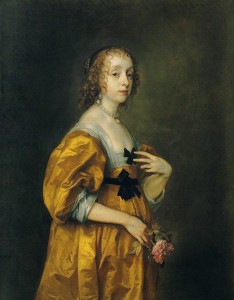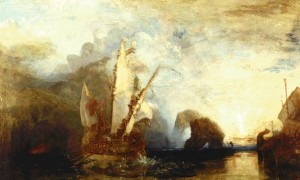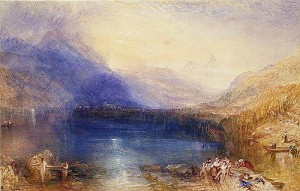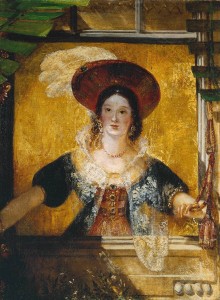“ [The painting of ] ‘The Center of the World’ became the hub of a wheel to which…everything that mattered was attached. When [Rhinebeck] saw Helen’s tunic fall in folds of gold and light about her incomparable shoulders, he saw Regine and that room in Paris when he was so much younger. He saw the very pulse of the world; he understood how empires rose and fell and that power and pleasure beyond his ability to imagine were before him to be grasped.”—A viewer’s reaction upon first seeing J. M. W. Turner’s painting of Helen of Troy
 Artist J. M. W. Turner’s masterwork, “The Center of the World,” purported to be an interpretation of the classical story of Helen of Troy, creates universal reactions of stunned disbelief among everyone who sees it for the first time. Some of these first-time viewers come close to venerating the painting in a religious sense, spending hours staring into it and experiencing the waves of pleasure that accompany every viewing. Because of its very nature and the powerful sexuality it exudes from within, however, it is a painting that the patron and the artist never planned to show publicly. Vanishing from sight almost immediately after the death of its patron, “The Center of the World” is certainly the “hub” of this novel’s “wheel,” drawing everything else into it as the novel unfolds through several different points of view and time frames.
Artist J. M. W. Turner’s masterwork, “The Center of the World,” purported to be an interpretation of the classical story of Helen of Troy, creates universal reactions of stunned disbelief among everyone who sees it for the first time. Some of these first-time viewers come close to venerating the painting in a religious sense, spending hours staring into it and experiencing the waves of pleasure that accompany every viewing. Because of its very nature and the powerful sexuality it exudes from within, however, it is a painting that the patron and the artist never planned to show publicly. Vanishing from sight almost immediately after the death of its patron, “The Center of the World” is certainly the “hub” of this novel’s “wheel,” drawing everything else into it as the novel unfolds through several different points of view and time frames.
On its surface, Thomas Van Essen’s debut novel is a quest to find the missing painting, but the novel is more than that. It is also a study of ecstasy, what creates it, and what enhances it, in art and literature (and even, indirectly, religion), and, of course, in real life. The novel’s various points of view, in time periods extending over more than one hundred fifty years, illustrate the history of this mythical painting from its “creation” to the present, convincing the reader that it is both real and as powerfully seductive as Helen of Troy herself. In 1856, five years after the death of J. M. W. Turner, famed art critic John Ruskin, a Turner expert “entrusted with the memory of England’s greatest painter,” is instructing a servant to burn some of Turner’s erotic sketches on both paper and canvas so that they will not damage Turner’s long-term reputation. The person doing the burning “had been to Paris when [he] was young and being no better than most young men, [he] had seen material of this sort for sale on the banks of the Seine.” What gives him pause, however, is a set of notebooks. “They seemed a study for a painting of some evil queen of antiquity. Ruskin said she was Jezebel. I didn’t say so, but I believe she was Helen. She was more beautiful than I can say.”
With a shift in time and setting, the reader learns more about “The Center of the World,” commissioned by George O’Brien Wyndham, third Earl of Egremont, during the time in which J. M. W. Turner was living at Petworth, Egremont’s estate. Turner was expected to use Mrs. Spencer, Lord Egremont’s mistress, as the nude model for Helen, and a handsome, young guest at the estate as the nude model for Priam. Life at Petworth is described in detail, and as the various relationships and events at the estate are revealed, the reader begins to understand the importance of this painting to the aging Lord Egremont.

Portrait of Lady Mary Villiers, painted by Sir Anthony Van Dyck, which dominated Charles Grant's bedroom at Petworth
Almost immediately after this brief section, the setting changes to that of the twentieth century and the point of view of a man who loves spending summers at a small property he inherited from his father at Saranac Lake in the Adirondacks. With an unexciting and not very remunerative job, the man is trying to figure out how to continue to pay for the upkeep of the cottage, which is part of a larger property belonging to a man whose assets seem unlimited. When the current owner of the “big house,” unexpectedly offers to buy the man’s property from him, the man wonders whether selling would be the right move. Shortly afterward, the point of view flashes back a couple of generations: Stokes, a man who is in financial difficulties, but who apparently possesses the mysterious Turner painting, is convinced to sell the painting to a Mr. Rhinebeck, wealthy owner of a large estate which he enjoys with his male friends.
Yet another point of view is that of Madison Partners, a contemporary corporation in which there is only one partner, Arthur Bryce, who deals with undercover art sales to avoid taxes. He is totally dedicated to finding the mysterious Turner painting, and he has just hired Gina, an intelligent and ambitious young woman to help him trace the painting through England and the United States, and he will stop at nothing. With these various points of view and a variety of time frames, the author is able to build suspense and create foreshadowing regarding the painting and its destiny. As the scenes at Petworth become more complex, the reader becomes involved in issues regarding the painting itself. Peripheral issues which take place in later time periods are also being developed, leaving the reader to process that additional information in order to solve the mystery.
The most crucial point, other than who has the painting, is the effect of the painting on those who see it. The author carefully illustrates the painting’s ability to overwhelm and emotionally capture the viewer, and he does not hold back in suggesting that much of the painting’s power is sexual. Drawing direct parallels between intense, sexual moments and the power of a painting to overwhelm the viewer, the author becomes graphic in his imagery. Some readers may be offended – and perhaps disappointed that the author chose to take this route, instead of drawing his parallels with greater subtlety. The explicit sexual images described here between men and women, and between men and men, will be, for some readers, as unnecessary as they are distracting. Romantic in its focus on personal feelings and the ongoing mysteries, the novel, overall, is exciting to read and insightful in terms of the work of J. M. W. Turner, even as it also leaves unanswered some important questions regarding the uninterrupted provenance of the painting. Van Essen, however, creates a lively discussion of the painting, its history, and its artistic elements, and by the end of the novel, few readers will care whether or not the painting is real.

Odysseus Deriding Polyphemus, a classical subject like that of Helen of Troy. Odysseus was a suitor of Helen.
Photos, in order: The author’s photo was taken by Mary Whipple at Book Expo America on May 30, 2013.
Petworth House, photographed by Jazpops, the photo of Petworth House appears on
http://www.tripadvisor.co.uk
The Van Dyck portrait of Lady Mary Villiers shows the dramatic contrasts between this style and that of Turner. Photo from http://pictify.com
In 1843, Turner returned from a trip to the Swiss Alps and painted a number of large watercolors like this one, “Lake of Zug.” http://www.metmuseum.org
“Jessica,” purportedly using Egremont’s mistress, Mrs. Spencer as a model, shows Turner’s weakness with figures. The painting is flat and lacks the subtleties of his landscapes. http://www.bbc.co.uk
“Odysseus Deriding Polyphemus,” one of Turner’s paintings of classical subjects, like that of Helen of Troy. Odysseus was supposed to have been one of Helen’s suitors, leading twelve ships from Ithaca to Troy. http://www.victorianweb.org/painting/turner/paintings/polyphemus.html
ARC: Other Press




